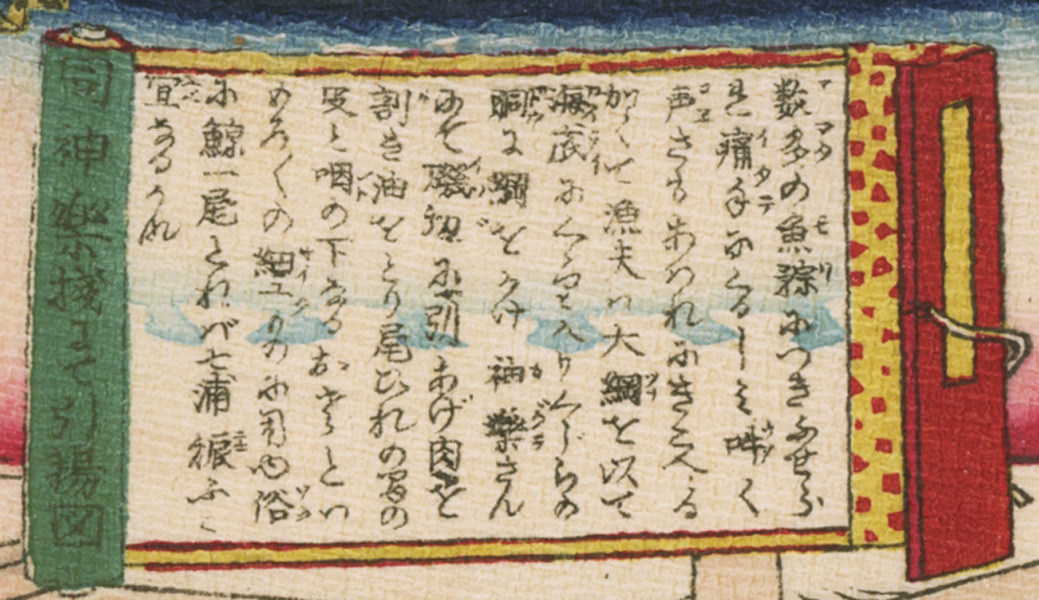About This Print
One of 118 prints in the series Dai Nippon Bussan Zue (Products of Greater Japan), issued in August 1877 to coincide with the opening of Japan’s first National Industrial Exposition (Naikoku Kangyō Hakurankai) held in Tokyo’s Ueno Park. It depicts the hauling onto shore of a whale for processing. The whale has been taken close to shore by a hunting party in fast chase boats (seko-bune 勢子船).
Iki Province (壱岐国 Iki no kuni) was a province of Japan which consisted of the Iki Islands, now a part of modern Nagasaki Prefecture. Its abbreviated name was Isshū (壱州). Iki is classified as one of the provinces of the Saikaidō. Under the Engishiki classification system, Iki was ranked as an "inferior country" (下国) and a "far country" (遠国).1
This crêped version of the print was made by the chirimen process, resulting in a cloth-like, smaller dimensioned, irregularly shaped print. (See the explanation in the Glossary under chirimen-e ("crêped" print)).A Little About Whaling in Japan
Source: Bringing Whales Ashore: Oceans and the Environment of Early Modern Japan, Jakobina K. Arch, University of Washington Press, 2018 and "History of the Traditional Diet: Japanese and the Whale" from Whale and Traditions of Diet, Japan Whaling Association, 1987.
The early Japanese viewed whales as deities of the sea as well as being useful for corralling fish. Many whaling villages built Whale Shrines, or Kujira Jinja, to worship the whales they hunted as gods.
As were many of the depictions of "products" in this series, this scene was likely copied from an earlier Tokugawa period work. (See the article Dai Nippon Bussan Zue (Products of Greater Japan) for more information.) When this print was issued in 1877 near-shore whaling had given way to off-shore, or open sea, whaling. By 1877 Japanese whaling was undergoing a transformation from traditional to modern practices forced upon them by declining near-shore whale populations. In traditional active whaling, whalers belonged to a specific whaling group (ōnaya) based out of a coastal village that had space on the beach for processing whales taken near shore (shore-based whaling). As inshore whale populations declined, larger open sea whaling ships were used to haul whales back to processing plants on shore and ownership of whaling operations passed to larger business groups, such as the massive Masutomi group, able to provide the bigger ships and on-shore facilities. By the 1920s factory ship whaling had begun in which harpooned whales taken on the open seas were towed to a centralized factory ship for processing.
Today, after a world-wide band on most whaling due to the decimation of whale populations, Japan continues to hunt whales. They hunt whales under an exemption allowing the taking of small catches for scientific study, after their appeal for an aboriginal exemption (based upon a claim of a 9000 year tradition of whaling) was rejected by the International Whaling Commission.
-coming-
click on image to enlarge
Multiple Editions (Variant Printings)
At least three variant printings (editions) were made of this series. Each variant printing uses a different colored cartouche containing the series' title, either red, green or rainbow-colored. Different colored borders were also used and variances in the use of colors and shading are present in the three editions. A crêped version of the series was also produced.
1 Wikipedia https://en.wikipedia.org/wiki/Iki_Province
| IHL Catalog | #1918 |
| Title or Description | Pulling Up a Whale 同[壱岐]神楽桟にて引揚図 |
| Series | Dai Nippon Bussan Zue 大日本物産図会 (Products of Greater Japan) |
| Artist | Utagawa Hiroshige III (1842–1894) |
| Signature | Artist's family name, Andō Tokubei, trimmed from the margin of this print. |
| Seal | none |
| Publication Date | 1877 (Meiji 10) |
| Publisher | Publishing information trimmed from the margin of this print. Ōkura Magobei 大倉孫兵衛 (Kin'eido; 1843-1921) [Marks: pub. ref. 627] |
| Impression | excellent |
| Colors | excellent |
| Condition | good - margins trimmed almost to image, normal misshapen size due to chirimen process |
| Genre | nishiki-e; kaika-e |
| Miscellaneous | |
| Format | chuban |
| H x W Paper | 5 3/8 x 7 7/16 in. (13.7 x 18.9 cm) |
| H x W Image | 5 3/16 x 7 3/8 in. ( 13.2 x 18.7 cm) |
| Literature | |
| Collections This Print | |
9/26/18
![Manufacturing Imari Porcelain in Hizen [Province], figure 2 from the series Dai Nippon Bussan Zue (Products of Greater Japan)](../hideo-hagiwara-1913---2007-/germination-2/Prior-print-rev1-30x30.jpg)
![Manufacturing Imari Porcelain in Hizen [Province], figure 1 from the series Dai Nippon Bussan Zue (Products of Greater Japan)](../hideo-hagiwara-1913---2007-/germination-2/Next-print-rev1-30x30.jpg)

